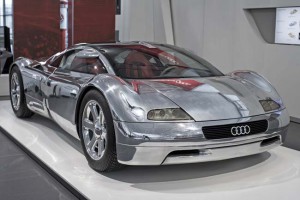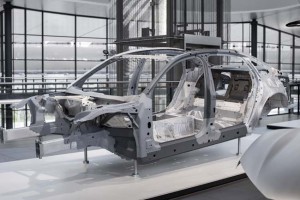2019 Audi A8 features hi-tech hybrid space frame
An all-new Audi A8 is coming to market shortly. Audi treats the range topping A8 sedan with a reverence that is befitting its flagship status and as such it benefits from the cutting edge of its technological expertise. We have just toured the brand new production facility in Nekarsulm, Germany, that will be the home of the expected 2019 Audi A8 sedan.
 Audi began experimenting with lightweight design in 1982. Besides an aluminum bodied 100 sedan in 1985, the first use of an aluminum framed vehicle was the 1991 Audi Avus concept car shown at the Toyko Motor Show. The specifications of this show car are spectacular, even by today’s standards. The frame weighed only 52 kilos and the aluminum body, roughly double that. Powering the sleek coupe was a 6.0L W12 engine boasting 509 HP.
Audi began experimenting with lightweight design in 1982. Besides an aluminum bodied 100 sedan in 1985, the first use of an aluminum framed vehicle was the 1991 Audi Avus concept car shown at the Toyko Motor Show. The specifications of this show car are spectacular, even by today’s standards. The frame weighed only 52 kilos and the aluminum body, roughly double that. Powering the sleek coupe was a 6.0L W12 engine boasting 509 HP.
The 1994 Audi A8 sedan was the first production vehicle that boasted an aluminum space frame (think of the frame as the skeleton of the car), the benefits were immediately apparent. The 1994 Audi A8 was the lightest full sized luxury sedan on the market. Light and luxury are two words seldom paired as the typical fitments associated with luxury vehicles tend to weigh the vehicle down. The genius of the Audi Space Frame was that it reduced weight in areas where the engineering would allow and out of sight of prospective buyers. It also allowed the increased performance in acceleration, cornering and braking due to the lighter weight to motivate and control.
Whereas the original ASF (Audi Space Frame) was all aluminum, Audi has been tweaking the composition of the ASF ever since and have used it on other vehicles, most noticeably the Audi R8 super-car coupe. Over time more sophisticated recipes for the ASF have been concocted.Further development of alloys and changing regulations regarding crash testing have brought about a revised philosophy at the Audi Light-weight research centre. The actual rundown of the processes used in creating the new ASF used in the upcoming A8, reads like a university doctorate in Chemistry or Physics. Suffice to say Audi has had to invent much of the processes used to deal with the manipulation and joining of 29 various materials used in the new Audi A8 space frame. Aluminum now accounts for only 58% of the frames composition.Most notably Audi has begun using hot and cold formed steel in crash bearing sections of the new frame. The lower sections of the firewall, the A and B pillars and cross members of the floor are now fabricated in high strength, hot formed steel. Many readers will recognize the corrosive issue of joining steel and aluminum. Audi has figured out that separating them with adhesive and joining the panels with high tech fasteners avoids the problem. The bracing that spans the cast aluminum shocks towers in the engine bay, is a cast piece of Magnesium. The rear panel and rear speaker deck in the new A8 is made of Carbon Fibre Plastic.
Interestingly, if you are able to see the bare frame as presented to us, you can view the individual sections as fitted together and many have their periodical makeup stamped on the pieces. It was truly a fantastic opportunity to see how sophisticated the metal structure has become.So after all the engineering and metallurgical wizardry how much lighter is the new ASF than the previous? Well its actually weighs more. What Audi has invested in is providing the highest tensile strength required by using the lightest weight of the part.
That being said, Audi now indicates that the body-in-white of the upcoming A8 will tip the scales at 282 kilos, up slightly from the previous model but still the lightest of any full-sized luxury sedan.Engineers have also pointed out that new Audi A8 frame will be 24% more rigid than the previous model. The effect of the tighter structure should be a quieter, better handling vehicle.We cannot wait to see what the final product looks like and more importantly drives like.
Copyright © Auto Reviews Online 2016 | Privacy & Terms of Use | info@autoreviewsonline.com | Website by Brolly Media
